- Time
- Post link
The day i get a D925 i will try to get the Jason and the Argonauts disc it will be really usefull :)
But the 925 wihtout a doubt beat the 2950 sharpness wise
The day i get a D925 i will try to get the Jason and the Argonauts disc it will be really usefull :)
But the 925 wihtout a doubt beat the 2950 sharpness wise
For those still playing along:
6(a). D925 - s-video - LG DVD Recorder (after AviSynth processing)
 <-- right-click/view for full size
<-- right-click/view for full size
Now with correct chroma decoding, and AviSynth processing (multi-cap average & levels tweak). For comparison with 4(b).
Detailed analysis to follow when I have time.
Guidelines for post content and general behaviour: read announcement here
Max. allowable image sizes in signatures: reminder here
As promised, here are the results of my scrutiny of images 4(b) (BT878 cap card) and 6(a) (LG DVD Recorder).
Firstly, the obvious differences - the DVD recorder faithfully includes the nominal analogue blanking regions (the black parts to the left and right of the image). This means that the aspect ratio is more accurate. If we assume that the test card is supposed to be a perfect circle, by my reckoning 4(b) has an aspect ratio error of 4.8%, while in 6(a) it is only 1.2%. It is of course possible to correct this, either by using the BT tweaker, or by capturing 704 x 576 then adding the NAB borders in post.
You should also be able to spot that the BT cap has more saturated colours. I didn't make any attempt to calibrate colours during the processing (only luma levels), but again this is not a big deal as it's something easily tweaked.
The comparison gets really interesting when you look at the images through a software waveform monitor. The LG recorder exhibits less noise in the luma midrange - the corresponding bars on the monitor are tighter, while the BT image has more line-to-line variability (zoom into the blue colour bar on 4(b) and you can see faint horizontal lines).
The LG image has more noise in the low and high ends of the luma range. There is a reason for this however - it is capturing a greater luma range than the BT card. The BT card tends to clamp the black and white areas, while the LG recorder captures and stores "super-black" and "super-white" luma values. Indeed, it manages to correctly capture the super-black strip in the PLUGE test pattern that appears earlier on the LD.
Looking forward to trying out the SAA7231 capture card.
Guidelines for post content and general behaviour: read announcement here
Max. allowable image sizes in signatures: reminder here
OK, so who remembers this thread?
I've recently revisited this test pattern again. Here it is again, after a multi-frame average and black and white levels corrected in Avisynth:

Now, from reading up about the components of this pattern, I believe the background is supposed to be a 50% grey. This background is too bright. Since the black and white points are correct, we'll use a gamma adjustment to darken it:

The grey bars above the colour bars end up being approx 75% after this adjustment - this is what they're supposed to be. This is to match the intensity of the colour bars as a reference. This works as follows: let's convert to RGB and show just the blue channel:

If everything was calibrated correctly, the colour bars would alternate black-blue; the blue bars would be the same intensity as the bars above and the blacks would be pure black. Now you see that some of the blacks have a little blue in them, and the blue bars are darker than the bars above. The first problem is fixed with a minor hue tweak, the second by a little saturation boost, now we get:

Not perfect, but pretty close. You can check the red and green channels too, if you wanted. So what effect does these further tweaks have on the final image?

There you have it - capture calibration complete!
Guidelines for post content and general behaviour: read announcement here
Max. allowable image sizes in signatures: reminder here
... and one final tweak to remove the slight green colour cast the previous image had:

Guidelines for post content and general behaviour: read announcement here
Max. allowable image sizes in signatures: reminder here
I noticed the other day that Sheldon (Big Bang Theory) has a shirt with this pattern on it. I couldn't stop myself from saying "You know, interesting story about that shirt..." ¬_¬
This signature uses Markdown syntax, which makes it easy to add formatting like italics, bold, and lists:
I "resurrected" this old thread of mine, just because today I posted in another thread some info about comb filters... then I realized I have a PAL CD-Video with a test card like the one Moth3r used here, so I decided to use it...
Here you are the screenshots - they are unprocessed, but the source is REALLY bad, full of speckles like the most part (if not all) of CD-Video around... the frame is always the same, captured with the same capture card, using the same cables (Monster Cable S-Video and LINN composite) - HuffYUV
Pioneer CLD-D925 composite:
Pioneer CLD-D925 S-Video:
Pioneer CLD-D925 through Panasonic DMR-ES15 DVD recorder:
Pioneer CLD-D925 through Pioneer DVR-320S DVD recorder:
The Pioneer DVR-320S clearly has the worst picture... look at the grey grid, and the red bar on the bottom of the circle.
The Panasonic DMR-ES15 has a strong TBC - clearly it can't be seen on static images, but when seen in motion, the captured clip shows almost no sync problems, unlike the other three clips. But the image is not the better - look at the grey boxes on the left, near the white ones... or, better, they are not grey!
The same problems could be found in the D925 composite output; in the D925 S-Video the problem is still here, but really reduced, compared to the other three captures.
Conclusions:
Sadly my projects are lost due to an HDD crash… 😦 | [Fundamental Collection] thread | blog.spoRv.com | fan preservation forum: fanres.com
Wow, that is pretty noisy. I've never seen a CD-V before, didn't realise they were so bad.
Can you try a multi-frame average - a simple TemporalSoften(2,255,255) as I did - to improve things?
Also, you say that the effect of a TBC can't be seen on a static image - this is not true at all, the effect is clear. The main advantage is that wobbly vertical lines, such as the vertical white line in the centre of the pattern, become straighter. See examples here showing what a good TBC is capable of. Very useful for VHS captures, but I don't think your TBC is helping you here.
Guidelines for post content and general behaviour: read announcement here
Max. allowable image sizes in signatures: reminder here
Yes, the CD-Video quality is AFAIK always the same... very bad!
About TBC: I don't know how to explain the fact that the moving images passed through the Panasonic recorder is more steady... maybe its due to TBC, maybe not... I will post some short clips tonight or tomorrow to show the difference.
Sadly my projects are lost due to an HDD crash… 😦 | [Fundamental Collection] thread | blog.spoRv.com | fan preservation forum: fanres.com
Just to confirm, did you use the DVD recorders in "pass through" mode? I assume you connected the LD player to the DVD recorder with a composite cable, then the DVD recorder to the capture card with s-video?
Guidelines for post content and general behaviour: read announcement here
Max. allowable image sizes in signatures: reminder here
Moth3r said:
Just to confirm, did you use the DVD recorders in "pass through" mode? I assume you connected the LD player to the DVD recorder with a composite cable, then the DVD recorder to the capture card with s-video?
Right.
Sadly my projects are lost due to an HDD crash… 😦 | [Fundamental Collection] thread | blog.spoRv.com | fan preservation forum: fanres.com
Moth3r: If you have the time, can you post a PNG of the Snell & Wilcox Zone Plate captured with your BT878 via s-video? (I can supply an m2v if you'd like...)
I'm interested in the resolution and chroma frequency response of the BT878.
A picture is worth a thousand words. Post 102 is worth more.
I’m late to the party, but I think this is the best song. Enjoy!
—Teams Jetrell Fo 1, Jetrell Fo 2, and Jetrell Fo 3
Maybe we can get someone to do an NTSC thread that does the same.....it's great to see such great info to learn from.
Cheers!!!!
AntcuFaalb said:
Moth3r: If you have the time, can you post a PNG of the Snell & Wilcox Zone Plate captured with your BT878 via s-video? (I can supply an m2v if you'd like...)
I'm interested in the resolution and chroma frequency response of the BT878.
Maybe one day, but my old BT878 card is boxed up somewhere in the garage; I have the SAA7231-based card installed at the moment.
I have the PAL version of DVE which I think has the Snell & Wilcox plate on it.
Guidelines for post content and general behaviour: read announcement here
Max. allowable image sizes in signatures: reminder here
Moth3r said:
AntcuFaalb said:
Moth3r: If you have the time, can you post a PNG of the Snell & Wilcox Zone Plate captured with your BT878 via s-video? (I can supply an m2v if you'd like...)
I'm interested in the resolution and chroma frequency response of the BT878.
Maybe one day, but my old BT878 card is boxed up somewhere in the garage; I have the SAA7231-based card installed at the moment.
OK, thanks. I'd greatly appreciate it!
A picture is worth a thousand words. Post 102 is worth more.
I’m late to the party, but I think this is the best song. Enjoy!
—Teams Jetrell Fo 1, Jetrell Fo 2, and Jetrell Fo 3
I've got 4 NTSC Laserdisc players and just got a Pioneer Elite CLD-97 which is considered one of the finest LD players ever produced. I do have a Panasonic DVD Recorder, as well as a Digital 8mm camera with pass through to FireWire that I've used for computer transfers. What is a decent PCIe type capture card if I wanted to go analog?
I have 100s of laserdiscs and would love do some decent captures.
Is there any chance someone could create a MP4 or AVI of the JASON AND THE ARGONAUTS test pattern?
“You people must realize that the public owns you for life, and when you’re dead, you’ll all be in commercials dancing with vacuum cleaners.”
– Homer Simpson
As requested, here are the test patterns from the Pioneer GGV1069 reference disc. Captured with a Pioneer HLD-X9 via an Intensity Extreme.
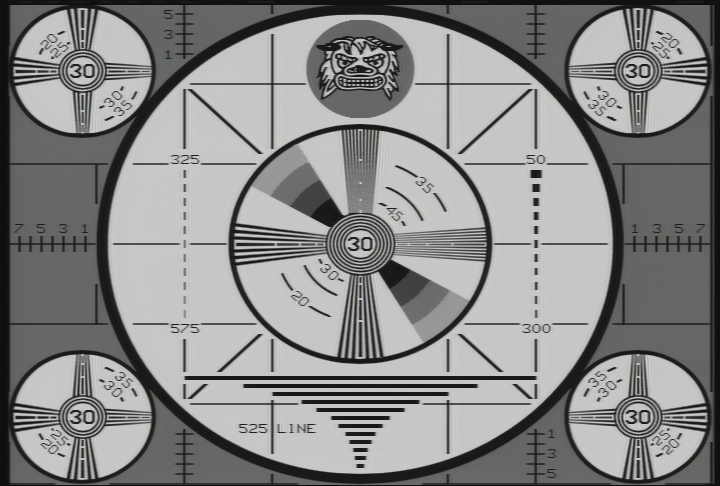
Donations welcome: paypal.me/poit
bitcoin:13QDjXjt7w7BFiQc4Q7wpRGPtYKYchnm8x
Help get The Original Trilogy preserved!
Ramp test pattern
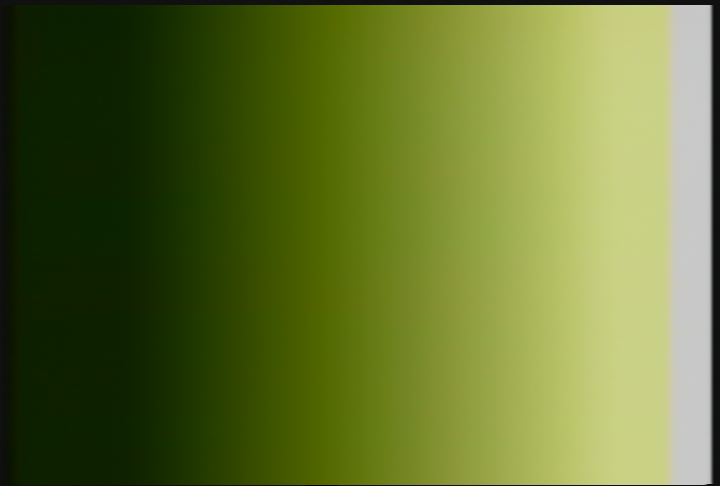
Donations welcome: paypal.me/poit
bitcoin:13QDjXjt7w7BFiQc4Q7wpRGPtYKYchnm8x
Help get The Original Trilogy preserved!
Dots

Colour Bars
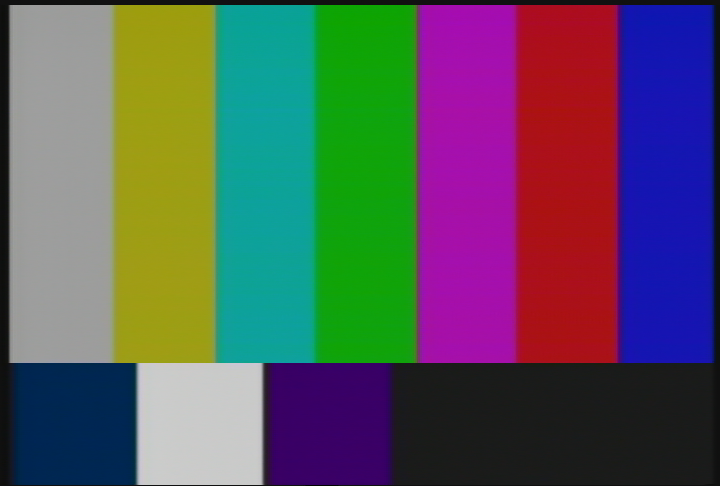
Donations welcome: paypal.me/poit
bitcoin:13QDjXjt7w7BFiQc4Q7wpRGPtYKYchnm8x
Help get The Original Trilogy preserved!
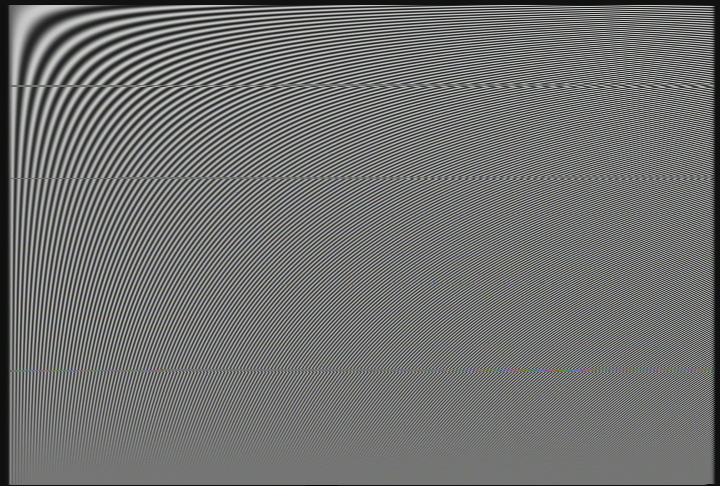
Donations welcome: paypal.me/poit
bitcoin:13QDjXjt7w7BFiQc4Q7wpRGPtYKYchnm8x
Help get The Original Trilogy preserved!
Is that using the X9's comb filter and the s-video output, or the composite output and the comb filter inside the Intensity Extreme?
Either way, it's a good result - there is no dot crawl between the colours on the colour bars, and no rainbowing on the moiré pattern (apart from at the glitch/linedrop about 3/4 of the way down).
Guidelines for post content and general behaviour: read announcement here
Max. allowable image sizes in signatures: reminder here
poita said:
As requested, here are the test patterns from the Pioneer GGV1069 reference disc. Captured with a Pioneer HLD-X9 via an Intensity Extreme.
That's similar to the Indian Head pattern that appears on A Video Standard. It's useful for checking sharpness, i.e. the vertical black lines under 7 5 3 1 should not have a white halo.
Interesting to see that the part of the multiburst above the centre circle is showing a small amount of residual "reflection" similar to the effect I saw with the Test Card G on the D925.
Guidelines for post content and general behaviour: read announcement here
Max. allowable image sizes in signatures: reminder here
poita said:
Colour Bars
Is there no PLUGE on these bars?
Guidelines for post content and general behaviour: read announcement here
Max. allowable image sizes in signatures: reminder here
Just for fun, here are three captures from the same JSC disc all using the same player, a HLD-X9.
Captured in 10bit RGB via a blackmagic intensity card.
On top is Composite output from the X9 straight to the BMI.
Middle is X9 Composite to a Panasonic DMR-ES10 then out to the BMI via Svideo.
Bottom is the X9 Svideo output direct to the BMI.
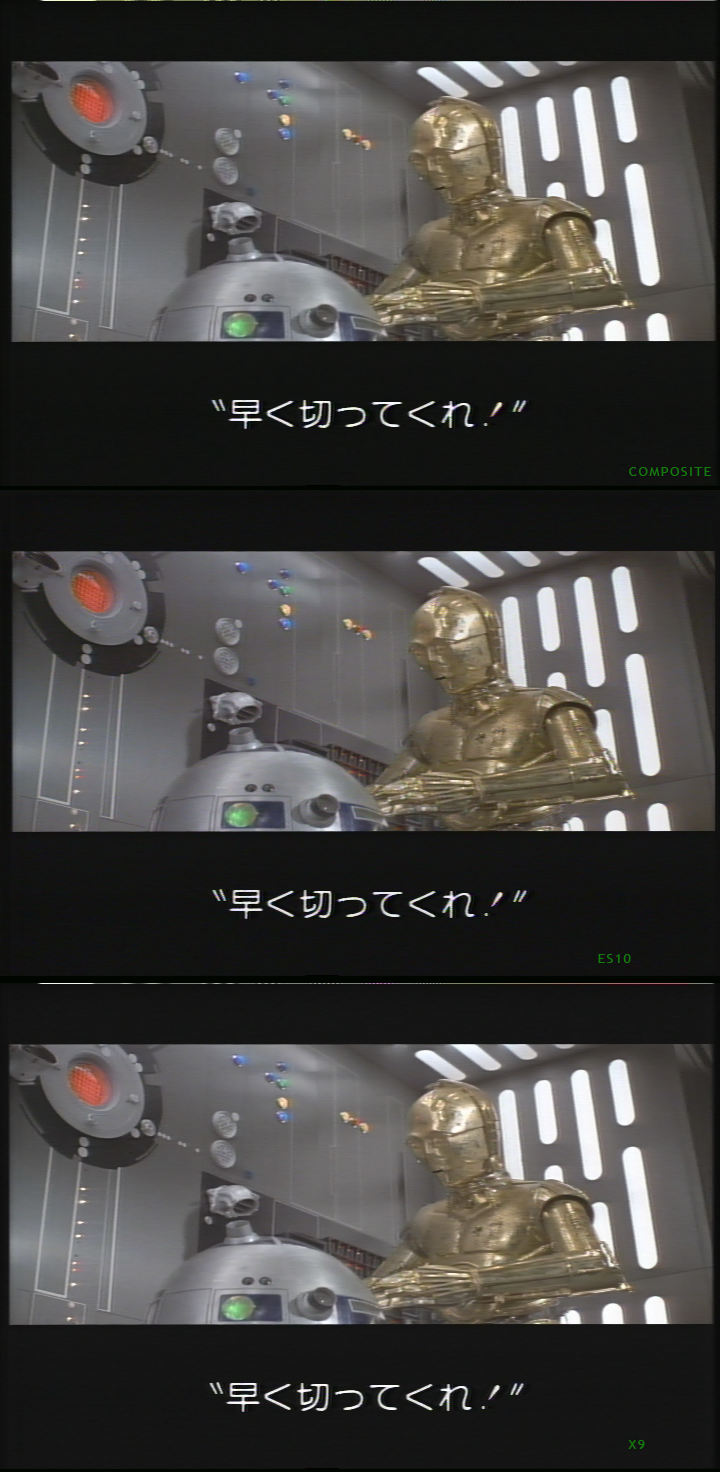
Donations welcome: paypal.me/poit
bitcoin:13QDjXjt7w7BFiQc4Q7wpRGPtYKYchnm8x
Help get The Original Trilogy preserved!